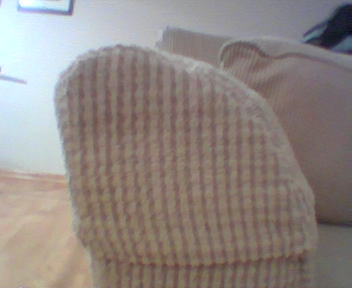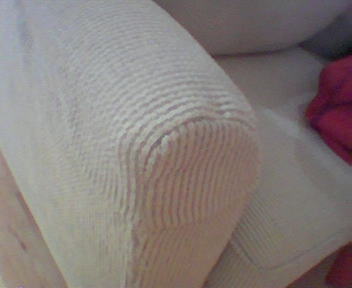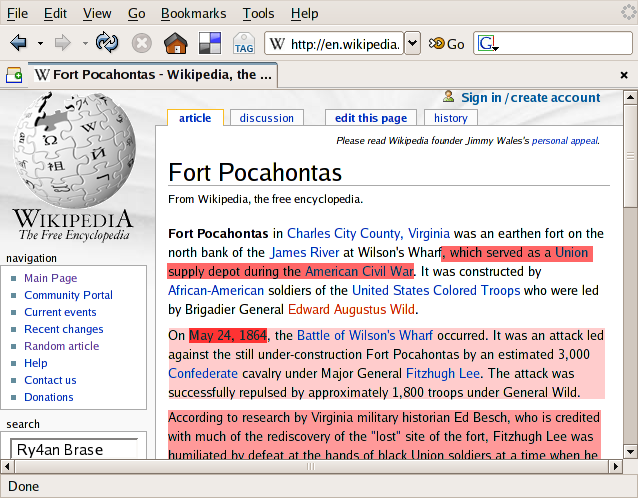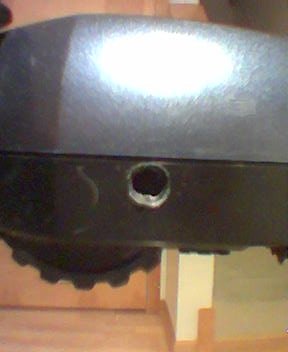Meager Home Improvements
After moving into the house I started a series of small home improvement tasks. Some of them have genuine safety reasons but many happened only because changing things demonstrates residence. Here's an incomplete list of things I've done:
- added a ceiling fan to the bedroom
- rewired the doorbell with modern wire so it doesn't ring everytime you walk past the dining room heat register
- added shelving, a phone jack and power outlets to create a server corner
- added appliance-grade outlets behind the stove and fridge (rather than the ungrounded lamp-grade extension cords running through holes in the floor they previously had)
- added a motion light to the break-in-ariffic back yard
- cleaned out the gutters (I knew there's a reason I got that condo)
- replaced the rotting wiring for the basement lighting
|https://ry4an.org/pictures/web/datacenter| |https://ry4an.org/pictures/web/motionlight|
Display Google Calendars with PHP iCalendar
Google has a new calendar service, and it's great. I really try to avoid hosted data solutions, but this one's just too good to pass up. My one gripe is that there's no easy way for non google calendar users to view the calendars. They're available live as both ical and rss/xml files, but the average home web user doesn't know what to do with either of those.
There are plenty of services out there that will display an ical file as a web page, but none of them I tested rendered the google ical output well, and all of them were packed with ads. Previously, I'd used software called phpicalendar to display ical files created by my old calendaring solution on the web, so I started there. It didn't parse the google output well either. However, with a little tweaking (see the patch in the zip file below) and some Apache trickery (see the README in the zip file) I can now get good phpicalendar output from google.
google-calendar-phpicalendar-2.22.zip
Update: Looks like now google offers a good way to do this.
Comments
Hey man I really want to get my php iCalendar working with my new Google Calendar as you have, but my server is not a Linux box, so I don't have a good way to patch the diff file you included in the zip. I was wondering if you would be willing to upload the actual files that you changed, or would you be willing to email them to me. I would really appreciate it.
Hrm, not to be unhelpful, but if you read the patch file you'll see I just commented out one block and added a simple if test somewhere else. It should be very easy to do by hand on the two files. The unified diff format is nice in that it's quite human readable despite being ready for machine processing. -- Ry4an
I'm not familiar with php icalendar, but (stupid question...) if using your work around, and I keep making new events in the google calendar, will they show up in the icalendar, or will some kind of cron job be required? (maybe I should just use the icalendar... but the google site is so seductive....) --Rebecca, cookieshouse.com
Yes, my phpicalendar hack does a live display of the google data. One could use phpicalendar all by itself, but I like the invites, access controls, and UI from google calendar well enough that I though it was worth trying to have phpicalendar do a live display of data I keep in google calendar. -- Ry4an
I was all excited to work on this little project. Then I realized I don't have the ability to apply patches (or if I do, I haven't a clue how to). Thanks for sharing though, it looks super cool on your site! --Rebecca, cookieshouse.com
I could not get your method to work so I had to rework the ical_parser.php. I recreated the $cal_filelist array with my google calendar urls. Then so the names of the calendars were not "basic" I created another array called $cal_names. Here maybe some source code will make this more clear. At about line 102 of ical_parser.php
$cal_filelist = array ("http://calendar url 1", "http://calendar url 2");
$cal_names = array ("Calendar Name 1","Calendar Name 2");
$counter = 0;
foreach ($cal_filelist as $cal_key=>$filename) {
// Find the real name of the calendar.
//$actual_calname = getCalendarName($filename); original code commented out
$actual_calname = $cal_names[$counter];
$counter++;
}
-- Psycho Whale
That's a more general solution than my quick hack. You might want to submit your code changes back to the phpicalendar project using their patch tracker. I'm sure they're getting all sorts of "support google calendar" requests and yours is a good step toward that. -- Ry4an
I applied your patch... no problem. But when I did the .htaccess edit, it would not redirect the .ics file to the google calendar. I then edited the config.inc.php to allow webcal's and added the exact patch of the .ics (which would be redirected) in the "$list_webcals[] = *;" area. No dice. It would then give me an error (which is strange since the file actually existed in that spot). Any idea what I'm doing wrong? Do I need to edit the "$default_path" in the config.inc.php to show the patch to the redirected .ics file also? I'd love to get this thing to work but doesn't seem to be happening. Tried Pycho Whale's solution also but that worked even less. Not sure if he was editing the ical_parser.php before or after your patch or if that even was relevent. Lot's a questions. Any help? -- RSmith423
If the .htacces file is ignoring your Redirect line it's because your httpd.conf file isn't set to allow Redirect lines in .htaccess files. You can either edit httpd.conf to allow Redirect lines in .htaccess files or you can just put the Redirect line directly into the httpd.conf file. Instructions for both can be found in the Apache online help. -- Ry4an
I noticed that recurring events don't display correctly. If you have a recurring event the start time and end time is always the same.
Here is my hack to PHP iCalendar to make it work:
in ical_parser.php:
my code:
ereg('^PT([0-9]+)S', $data, $duration);
$the_duration = $duration[1];
replaces this original code:
ereg ('^P([0-9]{1,2}[W])?([0-9]{1,2}[D])?([T]{0,1})?([0-9]{1,2}[H])?\([0-9]{1,2}[M])?([0-9]{1,2}[S])?', $data, $duration);
$weeks = str_replace('W', '', $duration[1]);
$days = str_replace('D', '', $duration[2]);
$hours = str_replace('H', '', $duration[4]);
$minutes = str_replace('M', '', $duration[5]);
$seconds = str_replace('S', '', $duration[6]);
$the_duration = ($weeks * 60 * 60 * 24 * 7) + ($days * 60 * 60 * 2\4) + ($hours * 60 * 60) + ($minutes * 60) + ($seconds);
Apparently Google uses seconds to specify the duration of the event, but PHP iCalendar expects the duration in hour minute second format.
Thanks for the patch!
-Charles
The only thing I had to do to get GoogleCalendar to work was the following:
phpicalendar/config.inc.php: $allow_webcals = 'yes'; phpicalendar/config.inc.php: $timezone = 'Europe/Paris'; php.ini: allow_url_fopen = On
And it worked right out of the box ...*
http:// YOUR-SITE /phpicalendar/month.php?cal=http://www.google.com/calendar/ical/ YOUR-GMAIL /public/basic&getdate=20060518
Thomas.
Excellent, maybe they've updated. I kept having it refuse to display any webcal URL that didn't end in '.ics', pehaps that's been fixed. Also, I found I needed to add some link text to the blank free/busy view entries for them to be clickable, but that would only be required if you use the free/busy (rather than full detail) view gcalendar provides. --* Ry4an
Condo on the Market
After a lot of cleaning, painting, and decorating my condo is finally on the market. Thanks to Kate and Natz for all their help. We've priced it very aggressively in hopes of not having this process drag on, so if we're lucky we'll be bidding a fond farewell to MLS 3165642 soon.
If you ever came by and admired the place, tell your house hunting friends.
Yet More Staging
Last week Kate, Natz, and I painted a few more rooms, added handles to the cabinets, added some bookshelves, and did a lot of minor repairs around the condo in preparation for selling it. I also cut up the throw pillows and sewed some arm covers for the couch. They look as cheesy as arm covers always do, but they hide the cat damage.


A Very IKEA Sunday
I'm finally tackling all the little projects I always meant to do around the house in preparation for selling it. Today I installed some simple roller shades downstairs and built a fairly complex multi-panel window covering system thing in the bedroom using the ridiculously modular KVADRANT stuff.
I've never had serious problems with IKEA stuff before, and these weren't any worse than usual, but one really is constantly beset by low-level disappointment at the quality of the pieces, their fit and finish, and the meager guidance the instructions offer when working with IKEA stuff. Still it's cheap and looks nice, which is exactly what one wants when staging for a sale.
Wiki History Overlay
Wikis, like ry4an.org, are websites meant to be easily edited. One simply clicks the edit button, changes the content, and poof the page is changed. One of the most famous wikis is Wikipedia, the free encyclopedia. It's a wonderful resource and chocked full of information. Unfortunately, due to its anyone-can-change-it-at-any-time freedom, some folks are hesitant to consider it a reliable reference.
Wikipedia's documented accuracy is largely due to careful edit policing by interested persons. I could go change the date of Abraham Lincoln's birthday right now, but someone monitoring the changes would detect the "vandalism" and revert the change in minutes. Sadly, anyone viewing the Abraham_Lincoln page between my edit and the repair would see the wrong birthday.
Wikis also have great history features. One can look at every old version of every page, and can see the when, what, and who for every change. That's usually enough to identify intentional vandalism. The history information, however, isn't presented with the article -- it's on a separate page. It's easily available but it's not presented with the primary content.
If, instead, the primary page text were altered to indicate where recent edits were made that data could be identified as suspect and the rest could be assumed to be well vetted. I've done a mock-up of such a display below:

Using text background colors closer to full red to indicate new data, we can see the year has been very recently changed, a phrase in paragraph one 2nd most recently, and that the last two paragraphs were added individually and in reverse order.
There are a variety of schemes one could use to color text, including:
- last three edits
- only edits made in the last week
- all edits colored by calendar age
- all edits colored by number of subsequent edits
What's more, the history information could be placed around the edit portions using CSS span tags, allowing the color rendering mode to be toggled or entirely disabled by the reader while viewing.
The CPU usage required to generate the history spans over the document may be quite intensive, especially, if more than just the last few edits are included. Pre-caching and other web trickery would help. One could even make an external viewer or perhaps even a greasemonkey script to insert the spans without burdening the wiki's server as much. External solutions for Wikipedia could use the database dumps.
Somewhat related: Some folks at IBM did a very cool project wherein they generated activity graphs for Wikipedia pages, but again that's on a separate page from the article, not embedded within it. It does, though, produce some pretty pictures.
Fixing the Roomba Circle Dance
My Roomba had been on the fritz lately. When I powered it on it went forward a few inches and then started backing up in a tight circle. I figured it was a dirty sensor, but I cleaned everything I could see and had no luck.
My coworker Brandon pointed me to the Circle Dance website, which explains how a dirty internal sensor can cause just that problem. I've got an older Roomba, but the wheel assembly seemed the same. The site has great instructions and photos showing how one can fix the problem. They do, however, go through incredible contortions, including removing 10 screws and a hard to replace panel, just to remove a single screw.
I found I could skip all that by drilling a small hole in the fender rather than removing it. Given that replacing the fender is so difficult the original site recommends not bothering, I think a hole is an acceptable level of resulting cosmetic defect.
This image shows just where the hole was made:

...and now the Roomba works great again.
KateAndRy4an.org
Kate Bauer and I put together the vanity/informational website for our wedding. Those joining us will find information on travel and hotels. Note the snazzy embedded google map on the bottom of the hotels page. Thanks go to Kate for writing most of the content and putting up with my insistance on hand-edited HTML.
The site also links to our engagement photos, where you can see how very lucky I am.
Improving Nick Tracking using String Similarity
Years back I wrote an IRC nick tracking script. It's served me well since then, but it has one major annoyance. When people changed their name slightly it would remember that name change, even though the old/new mapping didn't contain any real identity change information.
For example, when Gabe_ became Gabe it would display every message from him as <Gabe_(Gabe)>. That doesn't tell me anything interesting about who Gabe is.
I decided to tweak the tracker to ignore small changes in names. Computers don't think in terms like small they need a way to quantify difference and then see if it exceeds a specified threshold. Fortunately, lots of people have worked on just that problem -- mostly so that spell checkers can present you with a list that's close to the non-word you typed.
When I've worked with close enough strings in the past I've used the Levenshtein_distance as implemented in the String::Approx module or the ancient Soundex algorithm. This time, however, I tried out the String::Trigram module as written by Tarek Ahmed, which implements the method proposed by Angell in this paper. Here's an explanation from String::Trigram's README file:
This consists of splitting some string into triples of
characters and comparing those to the trigrams of some other string. For
example the string kangaroo has the trigrams "{kan ang nga gar aro
roo}". A wrongly typed kanagaroo has the trigrams "{kan ana nag aga gar
aro roo}". To compute the similarity we divide the number of matching
trigrams (tokens not types) by the number of all trigrams (types not
tokens). For our example this means dividing 4 / 9 resulting in 0.44.
Thus far, at a 50% match threshold it's never failed to detect a real change or ignore a minor-change, and if it does I should just be able to notch the match-threshold higher or lower. Great stuff.
The modified script can be viewed here and downloaded here.
Comments
If you wanted to only track nick changes in certain channels you'd add code line this at line 86:
return unless grep /^$chan$/, qw(#channelone #channeltwo #channel3);
I've modified 1.1 with a new /function, trackchan, that allows one to manage a list of channels where they want nick tracking to take place. If the list is empty, tracking will be done in all channels. The following is a unified diff.
What it doesn't do:
- Check to make sure that the channel you're passing in actually conforms to any standard channel naming conventions.
- Check to see if the channel already exists in the list before trying to remove it (though thanks to it just being a simple grep, no errors is returned in any case).
- Check to see if you're adding a duplicate channel to the list (feel free, it doesn't affect the functionality one bit).
- Have an option for printing the channel list. I think I will modify it to just print the channel list in addition to the usage if /trackchan is called with no arguments.
-- Gabe
--- nick-track.pl.orig Thu Dec 22 10:37:34 2005
+++ nick-track.pl.trackchan Thu Dec 22 14:50:30 2005
@@ -22,7 +22,7 @@
use Irssi;
use strict;
use String::Trigram;
-use vars qw($VERSION %IRSSI %MAP);
+use vars qw($VERSION %IRSSI %MAP @CHANNELS);
$VERSION = "1.1";
%IRSSI = (
@@ -47,6 +47,7 @@
'Asrael' => 'Sammi',
'Cordelia' => 'Sammi',
);
+@CHANNELS = qw();
sub call_cmd {
my ($data, $server, $witem) = @_;
@@ -84,6 +85,13 @@
my ($chan, $nick_rec, $old_nick) = @_;
my $nick = $nick_rec->{'nick'};
+ # If channel list is empty, track for all channels.
+ # If channel list is non-empty, track only for channels in list.
+ my $channels = @CHANNELS;
+ if ($channels > 0) {
+ return unless grep /^$chan$/, @CHANNELS;
+ }
+
if (defined $MAP{$old_nick}) { # if a previous mappings exists
if (String::Trigram::compare($nick, $MAP{$old_nick},
warp => 1.8,
@@ -101,6 +109,34 @@
}
}
}
+
+sub trackchan_cmd {
+ my ($data, $server, $witem) = @_;
+ my ($cmd, $channel) = split ' ', $data;
+ my @cmds = qw(add del);
+
+ unless (defined $cmd && defined $channel && map($cmd, @cmds)) {
+ print "Usage: /trackchan [add|del] #channel";
+ return;
+ }
+
+ if ($cmd eq 'add') {
+ push @CHANNELS, $channel;
+ print "$channel added to channel list";
+ }
+
+ if ($cmd eq 'del') {
+ @CHANNELS = grep(!/^$channel$/, @CHANNELS);
+ print "$channel removed from channel list";
+ }
+
+ print "Current channel list:";
+ foreach my $channel (@CHANNELS) {
+ print " $channel";
+ }
+}
+
+Irssi::command_bind trackchan => \&trackchan_cmd;
Irssi::signal_add("message public", \&rewrite);
Irssi::signal_add("nicklist changed", \&nick_change);
Thanks, Dopp, great stuff! -- Ry4an
Linux on the Dell X1
Yesterday I got the warranty replacement machine for my (company's) Dell X300 laptop. Dell mailed me an X1, which seems a nice enough machine. It meets my firm criteria: under 3 lbs and thinner than an inch. If Apple would hit those numbers I'd be there in a second.
Unfortunately, it looks like getting Linux on to this thing is going to be a pain. Emperor Linux will sell an X1 with Linux pre-installed, but they want $450 to take the X1 I already "own" and put Linux on to it. If they're not able to simply mirror a debugged installation over, that says a lot about their volume. I value my time pretty highly, but $450 for a software install seems extreme.
Fortunately there are plenty of pages detailing how to get Linux running on the X1. I'll muddle through the process and attach my notes as comments.
Comments
I've found that to boot Knoppix using the external optical drive I need to use this boot time invocation:
knoppix fromhd=/dev/uba
Now to try qtparted to squish down the NTFS windows partition to something reasonable.
Using ntfsresize and fdisk I was able to squish the windows install down to 10GiB. Now I'm just waiting for my fedora core 4 DVD to arrive for install.
Fedora Core 4 installed from the DVD without a hitch. I had to download the ipw2200 firmware RPM to make the wireless work. The 855resolution utility as invoked from rc.local and tweaked in xorg.conf got the resolution notched up. Next up... ion.
Tags
- funny
- java
- people
- python
- mongodb
- scala
- perl
- meta
- mercurial
- home
- security
- ideas-built
- ideas-unbuilt
- software
Contact
Content License

This work is licensed under a
Creative Commons Attribution-NonCommercial 3.0 Generic License.